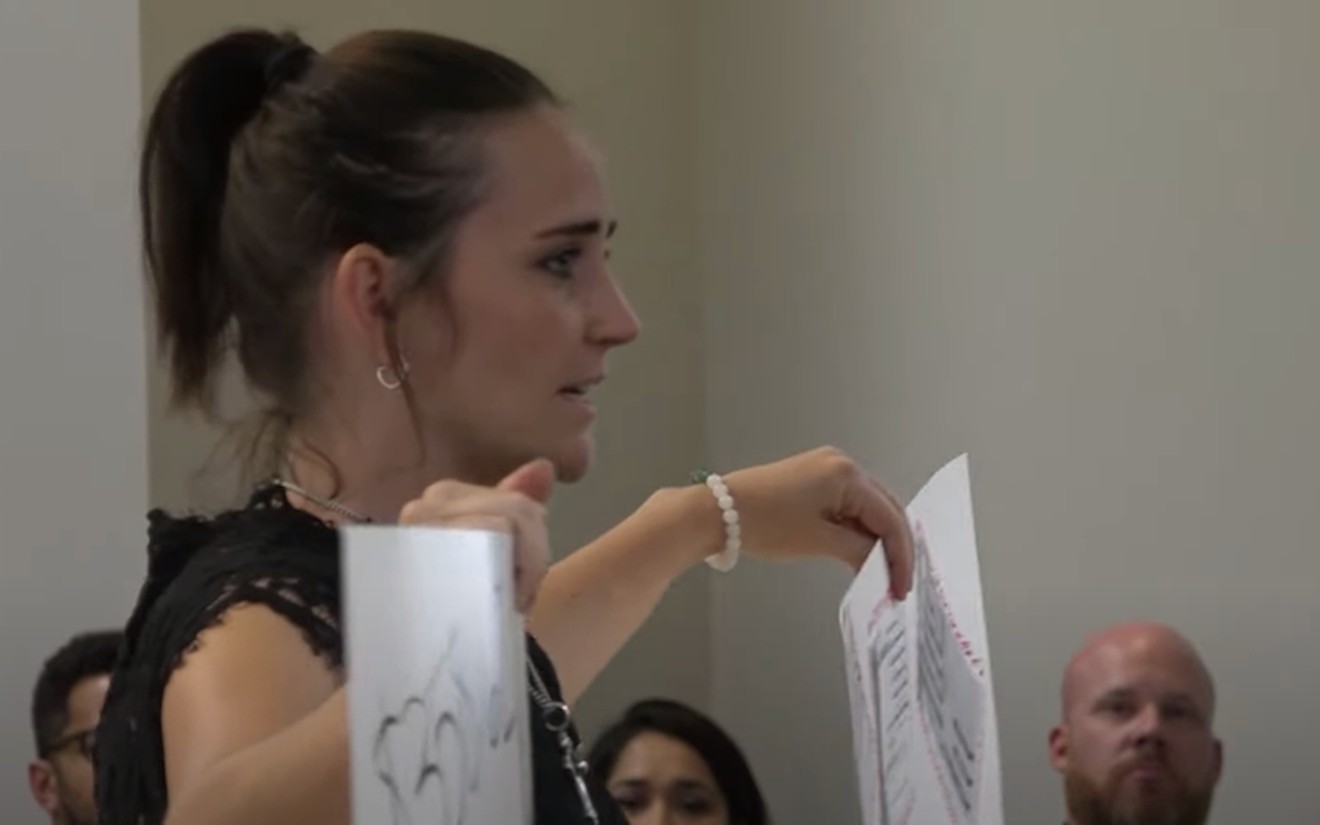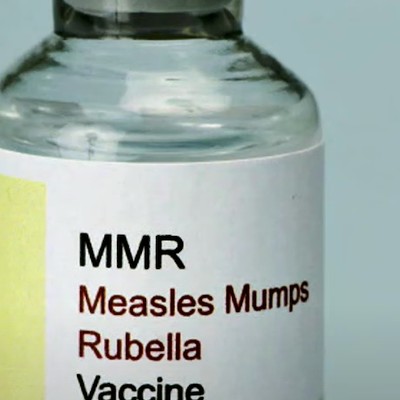What Amirian was unaware of was that her neighborhood was the epicenter of the city’s on-going water issues.
“I would bathe my daughter when we first moved in and the bathroom smelled like an indoor swimming pool,” Amirian said. “Some days, it would be dirty and discolored, and I immediately was like no we are not dealing with this.”
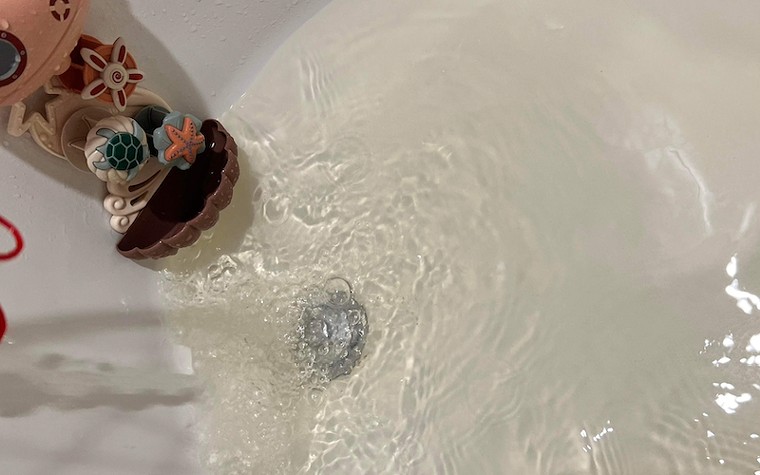
Before getting her water filtration system, Audrey Amirian would draw her daughter's bath water and see that it was often yellow or brownish in color.
Photo by Audrey Amirian
From August of last year until now, Amirian has counted about 14 days where water outages have occurred in her neighborhood. These outages at minimum last 15 to 20 minutes and can happen at any moment without any notice from the city.
When she calls the city, often people there are unaware an outage is happening, said Amirian. Along with outage issues, Mill Creek residents often experience low water pressure because of the over commitment of the city to developers purchasing water taps for new construction.
“I just think that when Mill Creek was developed the city was in over their head to be honest,” Amirian said. “I mean they approved way too many water taps than what they had the capacity for.”
In December, the Texas Commission on Environmental Quality issued a building moratorium as a response to an active violation for a lack of capacity in Magnolia's water system, according to a statement from the commission.
Though the moratorium provides some relief, as it states the city will not approve any new contracts for water taps, all the projects that have received approval before December 2022 can continue to build.
In response to the violation, the city has approved expansion of capacity by construction wells which should be able to circulate more water into their system and minimize the pressure issues the city has been having.
With these plans underway, Magnolia's Mayor and City Council have avoided pointing to what created this mess. Elected officials prefer to leave questions unanswered and reject concerned citizens' pleas to place these issues on council meeting agendas, Amirian said.
Subdivision builder DR Horton has been similarly circumspect. The Houston Press reached out to the city of Magnolia as well as DR Horton for an update on the status of the city's building moratorium and water-related issues via email and phone call but did not receive a response.
With current development continuing, Mill Creek residents are left wondering when the neighborhood’s water problems will be resolved and which users take priority.
“The city has all these water connections that have been approved for these commercial projects, and no water really left for the residents,” Amirian said.
How did Mill Creek get in the fix it's in now
Development is at the core of Mill Creek’s continuing water issues, as decisions made early in the development of the larger part of Magnolia laid the groundwork for what was to come.When Magnolia was in the early stages of development in 2013, the intersection between Spur 149 and FM 1488 was outside city limits. It became clear to the City Council that the intersection needed to be brought into city limits, said former Mayor of Magnolia Frank Parker, who served as mayor from 2001 to 2004.
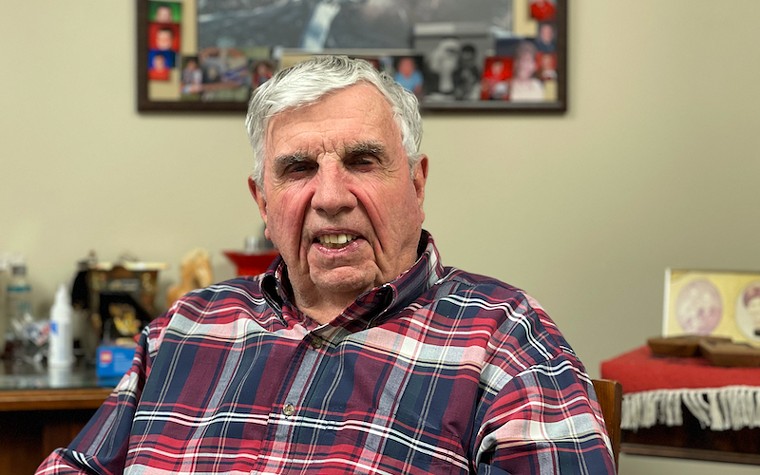
Former mayor Frank Parker, now works at Caliche, an environmental health, safety, and consulting firm in Magnolia.
Photo by Faith Bugenhagen
The city of Magnolia wanted to annex this area quickly to have space for this growth, but to do so they had to prove they could provide water and sewer. To do so, the city’s former engineering firm laid waterlines at the intersection. However, these lines were rushed in their construction and did not have enough of a volume of well water to provide adequate pressure for all the up-and-coming projects approved, Parker said.
These water pressure issues were brought to a head when H-E-B announced it was going to build a store at this intersection, according to Parker, everything just blew up.
The H-E-B project was approved in 2014 and completed just this past year in November 2022. Prior to opening, the fire marshal inspected the hydrants and refused to provide the store with an occupancy certificate because there was not enough pressure in its water system for the fire department to use it, said Parker.
H-E-B resolved its issues with the fire marshal but had to use its own money to bring the water system up to standard; many of the commercial projects out there still have pending occupancy certificates because they are having the same issues, said Parker.
The current city engineering firm, AEI Engineering, took over for the former firm in September 2021. When the firm recognized the pressure problems, they immediately notified the city, the current City Engineer Mike Kurzy said.
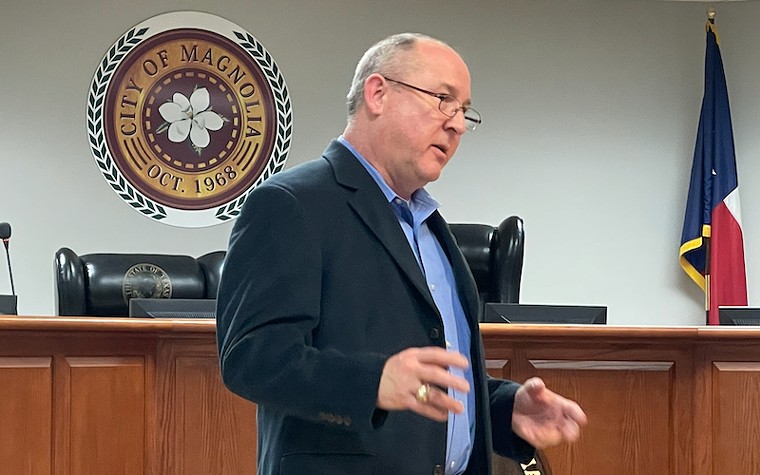
City Engineer Mike Kurzy addressing Magnolia residents in a recent public meeting about transportation.
Photo by Faith Bugenhagen
According to Kurzy, the system consists of tanks of stored water that can be rushed out to the water lines when the water drops below 50 PSI (pounds per square inch). Though this system provides relief to the city when it experiences low water pressure, due to the system’s limited capacity it does not provide the same level of assistance in subdivisions outside of the city, like Mill Creek.
To get more information about this temporary project and the construction details of this intersection, Parker filed his first public records request last December with the city. The city objected and filed an appeal that is currently pending approval with the Attorney General’s office.
Some of the documents Parker has requested have been given to him, however a majority have not, he said. Parker filed a second public records request on Wednesday, February 1, to try to bring the request to a close and figure out if he will be able to have access to the unprovided documents, Parker said.
Parker's additional request for these documents has not been answered yet, he said.
The poor planning of infrastructure mixed with the approval of almost every commercial and residential development project, including Mill Creek and their larger neighboring subdivision, Audubon, caused the city to lose control of the rate of development in the area, Parker said.
“Somewhere along the line, nobody was watching the home base,” Parker said. “They were so wrapped up in these big developments and all the money they were bringing in that they forgot about Magnolia.”
With new businesses opening and subdivision developers like Forestar continuing to build new homes in Mill Creek, Parker is concerned that if the city doesn’t slow down, it will be harder to catch up.
“Unless the city gets their act together, these issues are just going to be the first of many, it’s all going to snowball together,” said Parker.
The only solution that residents have right now, according to Parker, is the well construction plan that the city announced. Magnolia said they plan to construct two wells every year, for the next four years, to keep up with the rate of development.
Currently, the city has two main wells, with a third and a fourth that are in the process of construction; and a fifth was recently approved by the city.
Given that the temporary water project does not extend to areas like Mill Creek, residents of the subdivision are forced to wait on the fourth well which is supposed to rectify the low-pressure issues in the neighborhood, Kurzy said.
The well is estimated to be up and operating by May 2023, Kurzy said. “The well is progressing and this next week they’ll start pumping it out to see what kind and quality of water we will have,” Kurzy said.
Meanwhile, developers and builders continue to expand the projects they are working on.
“Eventually the city will have a water supply, but I think they’re just hunkered down right now hoping all these issues blow over once the wells are up and running,” Parker said. “My concern moving forward is if Magnolia will be smart enough to make sure they don’t do this again? It’s so easy to get caught up in big subdivisions and egos running around crazy and I just don’t know if they’ll have the discipline to not get caught up in it again.”
Why the price of water service is so high in Mill Creek
On top of these pressure and outage issues starting in August of this year, Mill Creek residents were still grappling with paying higher than average water bills. To try to find out why their water was costing so much, many residents got inspections to clear their house of leaks or other irrigation-related issues.David Womack, former Storm Water Investigator II for Harris County Pollution Control Service and Mill Creek resident said their water rate is already high when compared to other water services in the area.
“I have lived in these counties for 20 years, and this is the highest water rate I have ever seen,” Womack said. “I honestly have no idea why DR Horton would knowingly enter into this project, if they knew the rates would be this high for their residents.”
Womack said along with the rate, a charge from the San Jacinto River Authority — which has varied on his bill from $11 to $56 — made the water bills even higher.
“The kick is we are not even using the San Jacinto River Authority’s water because that is all surface water and with the well system here, we are on groundwater,” Womack said.
The San Jacinto River Authority charge Mill Creek residents pay is a charge everyone who lives in Montgomery County has to pay. According to Parker, this charge is a result of a contract the county entered with the San Jacinto River Authority in the event they would have to transition over to surface water.
The contract provided an easier, more cost-effective way for the city of Magnolia — who voted to approve this contract — to go on surface water. If the city council had not approved the contract, they would have had to construct a pipe that would cost millions of dollars to run water from Lake Conroe to Magnolia, as this is the nearest source of surface water, Parker said.
“If I moved into Magnolia and I didn’t know the history and I got a charge from the San Jacinto River Authority, I would be really upset too,” Parker said. “The residents aren’t using the water, they are just paying for the source of the water that isn’t being used, it makes no sense.”
What further complicates the situation is the location of Mill Creek. Because they are outside city limits, when it was time to put in the water and sewer lines, the city did not install them. Magnolia instead entered into a bond agreement with the closest Municipal Utility District, MUD 165, which put in Mill Creek’s sewer and water lines, said Parker.
Although Mill Creek is technically not a part of the MUD itself and is also not provided its water by the MUD, residents’ MUD taxes go toward paying for this infrastructure.
Womack is grateful because other than his initial bill, which was $300, he did not have high water bills and continues to get bills $110-125 around that are the average cost of water in that area. But some of his other neighbors haven't been as lucky.
Are the water meters faulty?
Bridget Spencer is one of the residents who faced problems with enormous charges, with her bills ranging anywhere from $600 to $1,700.Spencer approached the city administrator, Don Doering, who offered to replace her water meter to see if it was an issue with the current meter, Spencer said. Spencer was not the only resident that had a water meter replaced, as several other residents also had high bills and switched out their meters to see if this would fix the problem.
After having her original meter switched out, Spencer’s bills were still high. Spencer had her house checked and cleared of any leaks or irrigation issues that could’ve been contributing to the high costs.
Spencer contacted the mayor of Magnolia, Todd Kana, and reached back out to Doering to see if there was an alternative solution. Doering once again proposed switching the meter, but this time to a meter with a new meter reading device and software. This new meter would read the hourly rate of water usage, instead of the daily rate of usage, Spencer said.
However, when Spencer asked if Magnolia could also reimburse her for these high-water bills, the city employee said she could “keep her damn water meter” and hung up the phone, Spencer said.
“I asked the other woman on the line if I was understanding the situation correctly,” Spencer said. “That they were not going to be able to replace my water meter now, because I asked to be reimbursed for the high charges, and the lady agreed that was what was happening.”
Other neighbors complained about the possibility of incorrect meter readings. Despite these complaints, Kana is adamant that the city never found an issue with any of the meters they switched out.
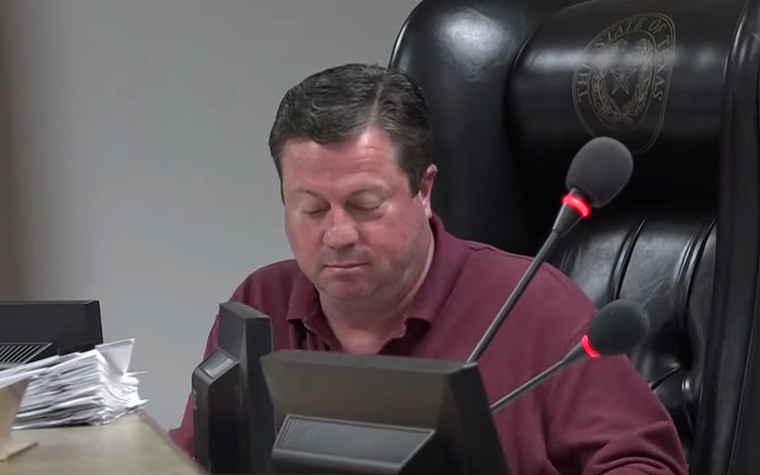
Mayor Todd Kana addresses the public at a city council meeting where Mill Creek residents gathered to discuss the high water bills.
Screenshot
According to Kana, meters from these residences were sent by the city to get independent testing and not one of these meters was outside of the American Meter Association standards.
“We knew that the water was going through their meters, and we tried to help them figure out what was going on, but every situation we were alerted to where residents claimed there was no way they were using that much water, they were,” Kana said. “I don’t know how many times we heard that, while we’re sympathetic to the situation, every time there were issues with the irrigation system or leaks or people were overwatering their lawns.”
Kana claimed that one of the residents who complained about these issues the most, realized after speaking with the city, that she was using as much water as the meter said.
Because the city has not found any fault meters, the mayor has repeatedly insisted to residents that their past high water bills were due to overwatering or irrigation system issues and leaks.
Some residents even conducted their own tests, standing outside and leaving the meter on while running their hoses to watch the amount of gallons the meter read, which according to them, didn’t correlate with how much water was coming out.
In February 2022 Spencer sent her monthly water bills to DR Horton. The builder did not get back to her until November 2022, when the lawyers that were working to help Spencer send a request for assistance to the company, Spencer said.
DR Horton then reached out to her via phone call to confirm they would take care of some of her higher water bills, Spencer thanked them and hung up the phone.
“I had sent emails since February 2022, and it took until November 2022 to respond and now they want to have a conversation with me? No, I don’t have a conversation for them, I really don’t like DR Horton or Magnolia,” Spencer said. “There’s nothing I have to say to either of them.”
According to Amirian, DR Horton stepped in and paid for several other residents’ high bills, in addition to paying for Spencer’s. Shortly after providing this assistance several of the salespeople that worked in Mill Creek were relocated.
Repeated attempts by the Houston Press to reach DR Horton for clarification on what the builder had done about residents’ complaints about their water bills did not receive a response.
And then there's water quality
Along with the higher than expected water charges most residents invested in whole-home filtration systems at costs ranging up to $10,000. This is expensive but is an essential need for them if they want to use or consume their water, Amirian said.
Audrey Amirian's sinks feature an additional water spigot where the filtered water comes out of. This is the spigot used when the Amirians' pour themselves glasses of water to drink.
Photo by Faith Bugenhagen
Common complaints from residents during the height of the neighborhood’s water issues included late departures to school because their children had to wait on the water to turn on to wash their face or brush their teeth. This was a larger problem in August, when outages were first occurring, as residents did not anticipate having these issues and had no water supply in storage.
Now that outages occur off and on, several residents include buying bottled water or gallon jugs in their weekly budget to have a water supply to turn to if needed.
“I have children coming home from school and a husband coming home from work and I need to cook dinner and I can’t even cook dinner, so now the water issues are costing me even more money because I have to go out and buy takeout for my family,” Spencer said. “It’s just a big inconvenience for everyone.”

Water from the back of a toilet tank, the water that usually collects here is clear, but during low pressure episodes turns super brown.
Photo by Audrey Amirian
In the past, the city has not posted TCEQ findings online; the residents would have to do their own search for the reports. Some residents have come together to discuss getting the water tested by a third-party organization, but the status of this test was put on hold for the time being due to a need to crowdfund for the tests’ expenses. Third party laboratory tests vary in cost depending on how extensive the test is, the most baseline start at $10 and can be upwards of $720.
After several complaints to TCEQ about this and the quality of the water, TCEQ did open an investigation on January 8 that is on-going.
TCEQ’s full statement given to the Houston Press below:
Since 2022, the TCEQ Houston Region office has received two complaints regarding color concerns with the City of Magnolia’s drinking water. Both complaints were received in December 2022 for the Mill Creek subdivision, and an investigation is currently ongoing. The ongoing investigation will focus on compliance with applicable drinking water regulations pertaining to color. The investigation includes compliance determinations regarding pressure and outages. The City of Magnolia has been actively working to address the capacity issue. The system has an active violation for a lack of capacity, and the compliance due date for that violation is in March. The Office of Water approved expansion projects for the City, which are well underway. It is our understanding that the City is currently waiting for a well pump for a newly-drilled well to arrive from manufacturing. Once it arrives, they should be able to address the capacity issue, which should minimize pressure drops in the system.”
This is not the first time the city of Magnolia has had issues with the quality or contents of the water supply. Computer technician and Magnolia Ridge resident Hal (who declined to have his last name used in this article) filed a complaint to TCEQ and a public information request to the city of Magnolia in 2018, after the city failed to report that traces of E. coli were found in the water in 2016.
“This shows a pattern from the city where they cut corners and don’t do what they're supposed to do and then it comes back to bite them in the butt,” Hal said.
Hal said that after going to TCEQ, several weeks later the city had posted a failure to report notice, but they never specified that it was a failure to report traces of E. coli in the water system.
“It’s a continued lack of empathy about it, they don’t think all these things are important, yet it’s affecting the residents,” Reed said. “Not everybody has the filters or equipment to make sure the water is safe, and the public isn’t even notified about when it isn’t safe. I mean this is a real systematic issue in the city.”
City accountability?
Multiple residents said that when they do go to the city about these issues with transparency and their operations, they are met with an unwillingness to assist by the staff.“I can’t speak specifically to a conversation that occurred between two other people, am I aware of some possible exchanges between residents and city staff? Yes, not specifically what was said, but the person most complained about is no longer there,” Kana said. “But I can’t even speak on whether the conversations they were having were truly a problem, because I never got specifics and I can’t comment on a ‘he said, she said’ without both parties standing in front of me.”
When Mill Creek residents attend city council meetings, they said Kana echoes the sentiment of the city staff, disregarding their issues on the basis that Magnolia is not beholden to Mill Creek, because their subdivision is outside city limits.
While city leadership has not been especially forthcoming, city employees have taken to their personal social media pages to comment about the issues in Mill Creek, Amirian said.
When Amirian confronted Kana about these comments, which disclose information about the neighborhood’s situation to these employees’ social media followers, Kana said they were doing nothing wrong and ignored the matter, Amirian said.
Kana did however issue a personal apology to Spencer, who reported a separate incident with a city employee.

One online interaction that occurred between a city employee and a resident of Mill Creek on both of their private social media accounts.
Screenshot
“I am not saying we have the best customer service, but I will say some of the phone calls that city staff are coming from people who are quite angry, and I’ll be honest they suffer language and abuse,” Kana said. “No person should have to and when a customer comes in using language directed towards someone personally that they don’t even know, that is not the best way to get results either.”
BUILDER TAKING BACKSEAT
Without the city taking much accountability over the water and infrastructure issues, some residents have looked to DR Horton for answers, but say the building company provides them with more problems.
Minnesota transplants, husband and wife Kathy and Chuck Connell, said their move in process with the builder was anything but smooth. On top of instantly having to put in a water filtration system after seeing the water quality, they also had to fight with DR Horton to get a retaining wall in their backyard because of irrigation issues.

Kathy and Chuck Connell made the move to Magnolia from Minnesota to be closer to their grandchildren.
Photo by Faith Bugenhagen
After Chuck discovered that their back lot would flood due to their neighbors’ house being raised higher than theirs, he told the building company that they had to put in the retaining wall.
“Honestly, there were so many small issues like that when we moved in it was a disaster, I would never buy from DR Horton again,” Chuck said. “I don’t understand how a builder of that size can try to cut corners like that.”
Womack, who lives with his wife, stepchildren, and mother, said he had similar issues with DR Horton, regarding his one of house’s electrical breakers and AC Unit.
The first issue was with one of the electrical breakers, which would trip out and not work, because there were four rooms on that single breaker. The breaker couldn’t handle the capacity of all four rooms, but Womack was told it was because the breaker was not grounded properly the first time. It was not until Womack got a different electrician to come out that the breaker was replaced.
His most recent run-in with DR Horton was about expanding his AC unit to another half ton. During the past summer, he noticed during dinner he would sweat as the house was not cooling below 75 degrees.
He requested assistance with the AC and was told that the house was not built to cool under 20 degrees of the outside temperature. Womack was in disbelief when he had a two-ton AC unit for a 1,800 square foot house and followed up continuously to upgrade the unit, until finally in October they did.
“I am not sure who is all to blame about the water issue, but I do know that DR Horton has got a lot of the blame going around for other things,” Womack said. “You have to fight and stay on top of them to get anything fixed and they are just not adamant about correcting issues.”
Again, DR Horton did not respond to repeated requests from the Houston Press to talk with us.
And that leaves us where? Up the Mill Creek without a paddle?
As some of these water issues became known to the public, Mill Creek had a string of cancellations come through, said Amirian. Amirian currently has a client who is closing on a property, despite Amirian’s warnings of low pressure and outages.“It’s tough as a realtor sometimes to know what I should say. I mean I tell all my clients what is going on, but I also tell them that Mill Creek and Magnolia is also a lovely place to live,” Amirian said. “It’s just difficult, I didn’t know what I was getting myself into because I was never told until I moved in, some realtors that have listings in the area genuinely don’t know.”
Amirian and other residents are hoping that like the city said, the wells that are constructed will resolve the water issues that they are faced with. However, Amirian is concerned, particularly because the well that is approved that is closest to Mill Creek will not be completed until December 2023.
“I am glad that the city is thinking about long term solutions by adding wells, but what are we supposed to do, wait 11 more months for consistent water?” Amirian said. “There is literally no one helping us, protecting us, or advocating for us in the short term.”
The city of Magnolia is currently under a Stage 2 Water Restriction, Amirian said the city’s plan is to keep this restriction in hopes that it preserves enough water to carry them through this summer.
She is concerned that this plan won’t do enough to cover the needs of the residents during this peak season.
“I am worried about the summer, that preserving by instating these restrictions won’t be enough, then what will we do?” Amirian said.

